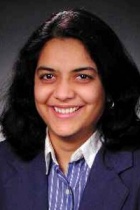Surya Mallapragada
Iowa State University
Professor, Department of Chemical and Biological Engineering
Topic: Biomaterials to Modulate the Tissue Microenvironment
This talk will focus on two different collaborative projects that illustrate how biomaterials can be tailored to provide chemical or electrical cues to surrounding cells and tissues to achieve desired outcomes for treatment.
The first part of the talk will focus on how nanomaterials can be used to deliver combination therapies for the treatment of pancreatic cancer. Pancreatic cancer has a very high fatality rate, and the current treatment using gemcitabine (GEM) does not work effectively, partly due to desmoplasia. Development and use of dual delivery nanoscale devices to deliver miR-345 and GEM together resulted in downregulation of the Sonic hedgehog signaling pathway and led to inhibition of desmoplasia, pancreatic stellate cells and cancer stem cells. This, in turn, improved therapeutic outcomes of GEM in pancreatic cancer in mice through improving its perfusion in the tumor, and also led to significant reduction of metastasis.
The second part of the talk will focus on biomaterials to control stem cell fates. Over 200,000 peripheral nerve repair surgeries are carried out each year. The current gold standard for treatment involves autografts, which suffer from significant drawbacks such as partial denervation at the donor site. A promising alternative involves degradable conduits seeded with Schwann cells to provide physical guidance and to secrete neurotrophic factors to facilitate peripheral nerve regeneration. However, due to the difficulties in obtaining Schwann cells for this treatment, we have developed a 2D graphene inkjet printed circuit to electrically stimulate readily-accessible bone marrow-derived mesenchymal stem cells and transdifferentiate them to Schwann cell-like phenotypes. We have demonstrated enhanced secretion of nerve growth factor (NGF) from the transdifferentiated cells as opposed to the undifferentiated MSCs. This is the first time that transdifferentiation of MSCs to Schwann-cells have been successfully achieved solely with electrical stimulation.
Biography
Surya K. Mallapragada is Anson Marston Distinguished Professor and Carol Vohs Johnson Chair of Chemical and Biological Engineering and the Associate Vice President for Research at Iowa State University (ISU). She received her chemical engineering education from IIT Bombay (B.Tech, 1993) and Purdue University (Ph.D., 1996). She has courtesy appointments in the Materials Science and Engineering department and the Neuroscience program at ISU. She served as Chair of the Department of Chemical and Biological Engineering from 2009-13. She is also a Senior Scientist and has served as Program Director of Materials Chemistry and Biomolecular Materials (2004-08) at Ames Laboratory, a US Department of Energy Laboratory. Her research interests are in the area of polymeric nanobiomaterials, specifically in drug/gene and vaccine delivery and neural tissue engineering, and in the area of bioinspired materials. She has over 150 publications and serves as an Editor of Materials Science and Engineering: R: Reports.
Her work has been recognized by several awards including a National Science Foundation Career award, a 3M Non-tenured faculty award, Iowa State University Foundation Early as well as Mid-Career Excellence in Research awards, a Big 12 Rising Star Award, an IIT Bombay Young Alumni Achievement Award and the Boylan Award for Outstanding Research. She was named one of the top 100 young innovators by MIT’s Technology Review magazine and is an elected Fellow of the American Institute for Medical and Biological Engineering (2006) and the American Association for the Advancement of Science (2008). She was recently elected a Fellow of the National Academy of Inventors (2016) and the International Academy of Medical and Biological Engineering (2017).
Surya has served the Food, Pharmaceutical and Bioengineering Division of the American Institute of Chemical Engineers in several capacities, including chairing the division. She received the Distinguished Service Award from the American Institute of Chemical Engineers’ Food, Pharmaceutical and Bioengineering Division in 2009 for sustained and committed leadership and service.
Wednesday, May 2, 2018
- Time: 11.00 AM
- Location: 206 Furnas Hall
- Seminar Flyer

Surya Mallapragada, Professor
Iowa State University